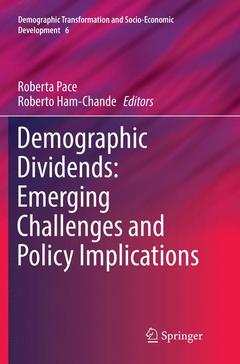Description
Demographic Dividends: Emerging Challenges and Policy Implications, Softcover reprint of the original 1st ed. 2016
Demographic Transformation and Socio-Economic Development Series, Vol. 6
Coordinators: Pace Roberta, Ham-Chande Roberto
Language: English
Subject for Demographic Dividends: Emerging Challenges and Policy...:
Publication date: 06-2018
Support: Print on demand
Publication date: 08-2016
Support: Print on demand
Description
/li>Contents
/li>Comment
/li>
Introduction : Roberto Roberta Pace and Ham-Chande.- The Common Link between Policies Conducive to both Demographic Dividend and Fertility Transition: Anrudh K. Jain.- Population Ageing, Demographic Dividend and Gender Dividend: Assessing the Long Term Impact of Gender Equality on Economic Growth and Development in Latin America: Tim Miller, Paulo Saad and Ciro Martínez.- Demographic Dividends and Household Saving in Mexico : Isalia Nava-Bolaños and Roberto Ham-Chande.- Demographic Transition in Sub-Saharan Africa: Implications for Demographic Dividend: Yoonjoung Choi.- Age-Structural Transition and Demographic Windows around the Mediterranean: Maria Carella and Alain Parant.- The Potential Collateral Demographic Dividend: Natalie Jackson.- Beyond the Demographic Dividend: Demographic Transitions and Empirical Evidence in Italy: Roberta Pace and Nadia Mignolli.
Gives a multi-dimensional approach to the Demographic Dividend Analysis
Identifies three typologies of demographic dividend in different world areas Collects the experiences of middle-income countries to better understand the opportunities that could be obtained by detailed demographic and economic analysis




